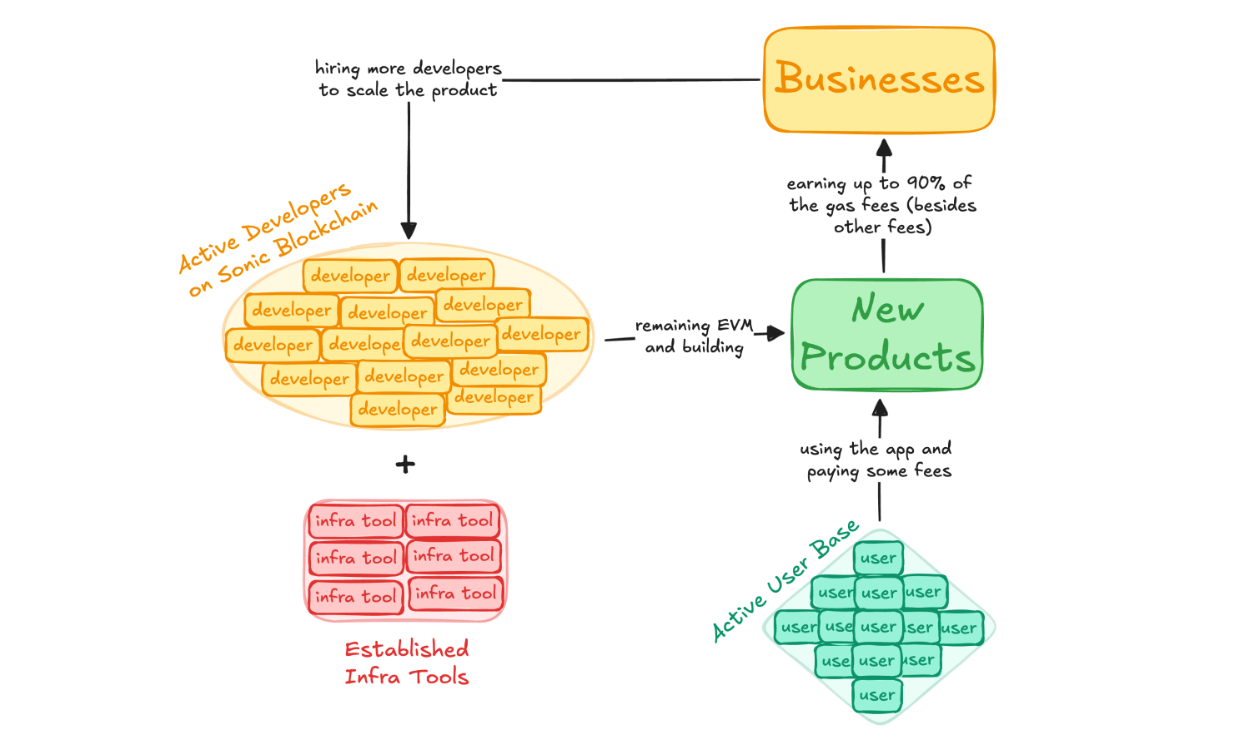
What Is Sonic Blockchain?
Sonic is a next-generation Layer 1 blockchain designed to deliver high speed, security, and scalability. The platform can process up to 10,000 transactions per second and achieve finality in less than one second. Sonic aims to be the foundation for decentralized applications (DApps), smart contracts, and innovative projects. The native token of the Sonic blockchain, S, is used for transaction fees, staking, and ecosystem governance.
 Sonic Ecosystem. Source: soniclabs.com
Sonic Ecosystem. Source: soniclabs.com
Differences Between Sonic and Other Blockchains
Sonic stands out from other blockchains thanks to its innovative approaches and technical features. Here are the key differences:
-
Speed and Scalability: Unlike traditional blockchains like Ethereum, Sonic finalizes transactions in less than a second. This ensures users experience fast and reliable transfers with no delays. The network also supports up to 900 million transactions per day, making it ideal for large-scale usage.
-
Dynamic Fee Structure: Sonic introduces a feature called Fee Monetization, allowing developers to earn up to 90% of the fees generated by their applications. This encourages the creation of new DApps and supports the network’s internal economy.
-
Decentralization and Security: Sonic relies on its own validators to secure the network, eliminating long waiting periods typical in optimistic rollups like Arbitrum or Optimism. This reduces the risk of hacks and improves the overall reliability of the network.
-
Sonic Gateway: The Sonic Gateway makes it quick and easy to transfer assets between Sonic and Ethereum. For example, transactions from Ethereum to Sonic take up to 10 minutes, while transfers back to Ethereum can be completed within an hour.
What Makes Sonic Unique?
Sonic has distinctive features that set it apart from other blockchains, making it a next-generation platform. Here are the key aspects:
1. Enhanced Compatibility With Ethereum
Sonic improves integration with the Ethereum Virtual Machine (EVM), allowing developers to use familiar tools like Solidity and Vyper. This makes creating smart contracts and decentralized applications (DApps) on the Sonic platform simple and efficient.
2. Sonic Gateway
Sonic Gateway is a unique bridge that enables fast and secure asset transfers between the Ethereum and Sonic blockchains. It supports the movement of ERC-20 tokens, such as USDC, with minimal delays:
-
Speed: Transfers from Ethereum to Sonic take up to 10 minutes, while transfers back to Ethereum are completed within an hour.
-
Security: The Sonic Gateway uses a decentralized network of validators operating across both chains, eliminating single points of failure and enhancing user fund protection.
-
Simplicity: Users can start working with Sonic instantly without facing technical hurdles. The Gateway ensures seamless integration of Sonic with the Ethereum ecosystem.
The Sonic Gateway addresses major challenges of traditional bridges, such as long delays and high security risks, providing a modern solution for cross-blockchain interactions.
3. Developer Program (Innovator Fund)
Sonic Labs actively supports developers by allocating up to 200 million S tokens through its Innovator Fund. This program encourages the creation of new decentralized applications and infrastructure, driving growth in the Sonic ecosystem. It focuses on accelerating innovation and supporting startups that choose Sonic as the foundation for their solutions.
Sonic continues to impress with its advanced technology and developer-friendly platform, making it an ideal choice for future blockchain projects.
Migration From Fantom to Sonic
Sonic was developed as the next step in the evolution of Fantom, utilizing more advanced technologies to improve user experience. The migration from Fantom to Sonic was approved by the community through voting and includes an automatic 1:1 swap of FTM tokens for S tokens.
For the first 90 days, the bridge supports two-way transfers between Fantom and Sonic. After this period, it switches to a one-way mode, allowing only transfers from Fantom to Sonic. This ensures a smooth transition for users to the new platform while preserving their assets and functionality.
S: Native Token of the Sonic Network
S is the native token of the Sonic network, playing a vital role in its ecosystem. Its total supply is 3.175 billion tokens, matching the number of FTM tokens at the time of launch. All FTM holders can swap their tokens for S on a 1:1 basis.
 S Token Emission Chart for Sonic Network Over the First 7 Years: Distribution by Categories (Block Rewards, Funding, Airdrop, and Opera Reallocation). Source: soniclabs.com
S Token Emission Chart for Sonic Network Over the First 7 Years: Distribution by Categories (Block Rewards, Funding, Airdrop, and Opera Reallocation). Source: soniclabs.com
Use Cases of S
The S token serves multiple functions within the Sonic ecosystem:
-
Transaction Fees: Users can use the S token to pay transaction fees within the network, making it the primary means of interaction with the blockchain.
-
Staking and Network Security: S token holders can participate in staking to help secure the network. The minimum amount required for staking is 1 S, while running a personal validator requires 50,000 S. With Sonic Wallet, the staking process is simple and secure for users.
-
Governance: The S token allows users to vote on changes within the ecosystem, influencing its development and governance.
-
Integration With DApps: The token is used within decentralized applications on the Sonic network, providing users with access to unique features and opportunities.
Sonic is building an innovative future focused on speed, decentralization, and convenience for both users and developers.
